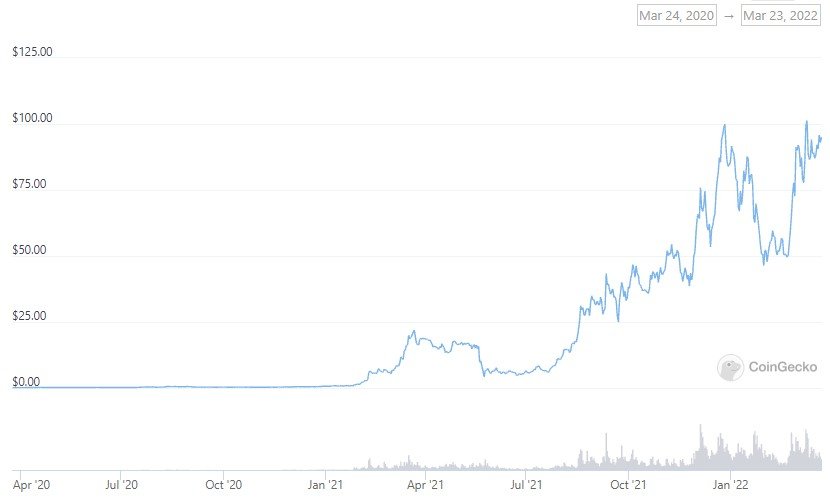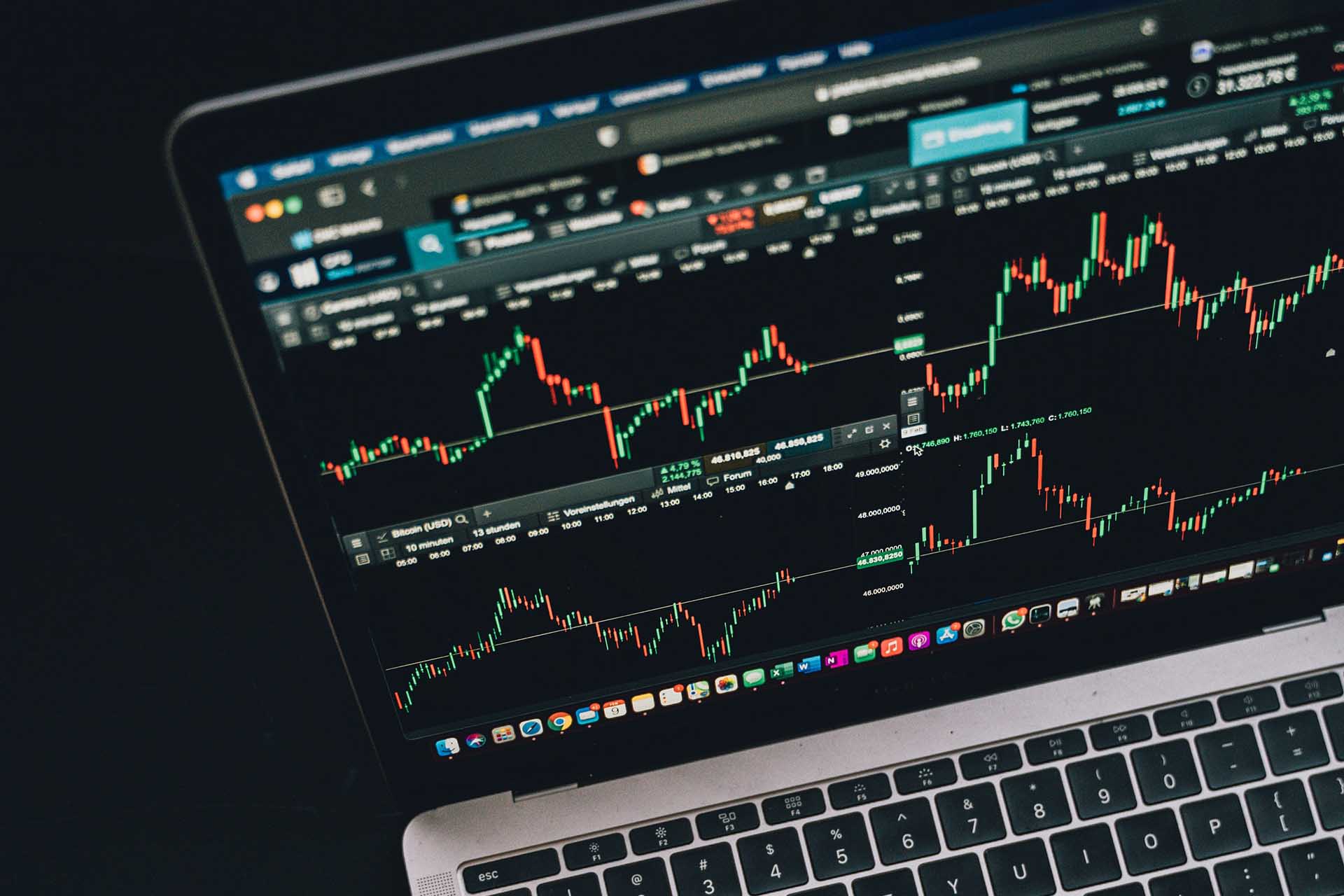Terra Luna coin, better known as Luna, is the native token of the Terra ecosystem.
At a high level, Luna’s price is driven by the adoption of the blockchain network Terra. As demand for algorithmic stablecoins grows, so too will the price of Luna. This is because Luna is algorithmically tied to UST, Terra’s U.S. dollar-pegged stablecoin.
To better understand its price mechanics and what fueled Luna’s meteoric rise in 2022, let’s first back up and review: What is a decentralized stablecoin?
What is a stablecoin?
A stablecoin is a cryptocurrency whose value is stable and tied directly to the price of another asset. Stablecoins can be pegged to other currencies, stocks, commodities, etc. In the world of crypto, stablecoins are most often used in conjunction with fiat currencies like the U.S. dollar. Tether, USD Coin, and TerraUSD are all widely used U.S. dollar-pegged stablecoins.
Why would someone buy a stablecoin?
Stablecoins serve several purposes but the most obvious is to serve as a safe, or stable, holding ground in the notoriously volatile crypto markets. If you want to keep money on a crypto exchange, you can use a stablecoin while in between trades or investments.
Besides being stable, stablecoins offer a couple of other key benefits. Unlike other cryptocurrencies, the prices of stablecoins don’t fluctuate much, if at all. This means they do not incur capital gains, though they do technically still trigger taxable events.
Stablecoins are also fast and very cheap to use. Transacting with a stablecoin can cost as little as a fraction of a cent, and can settle almost instantly. Compare that to international money transfers, which can take several business days and charge between 1% and 6% of the total value transferred.
Okay, but why buy a decentralized stablecoin?
Stablecoins first emerged around 2014. Though projects like Tether (USDT) and USD Coin (USDC) ostensibly solved the issues highlighted above, many investors questioned exactly how these stablecoins were guaranteeing their peg to the U.S. dollar.
These stablecoins are controlled by centralized authorities that claim to back their coins 1:1 with assets of the equivalent value, but investors had no way to confirm the company’s claims.
As the crypto community continued to develop a decentralized financial system, relying on centralized stablecoins felt like an unnecessary risk and a narrative violation to many investors. This friction paved the way for Terra.
Terra is an open-source blockchain platform for decentralized stablecoins. These stablecoins are managed algorithmically and remove the need to trust the actions of a centralized regulating authority. “How does this algorithm work?”, you ask. That’s where the case for Luna gets interesting.
What is TerraUSD?
TerraUSD, or UST for short, is Terra’s algorithmic stablecoin that is tied to the U.S. dollar. In order to guarantee the value of UST at exactly $1.00 in the face of fluctuating supply and demand, Terra created LUNA. Terra Luna, or rather Terra Luna’s link to UST, is what stabilizes UST. And that is no small feat…
UST is now the largest decentralized stablecoin in existence, currently the 14th largest cryptocurrency by market cap according to CoinMarketCap. UST is used extensively in DeFi (decentralized finance) and in South Korea since the transaction fees are 60% cheaper than credit card fees, and it’s gaining momentum quickly.
The price mechanics of Terra Luna coin
Think of Luna as the balancer that keeps Terra at a fixed price. To mint UST or another Terra-based stablecoin, Luna tokens must be burned (destroyed). Currently, Luna is trading around $90, so burning 1 Luna would mint 90 UST.
When demand for UST increases, this creates upward pressure on the price of the stablecoin. As the price rises above $1, Luna holders can burn their tokens to mint UST at exactly $1 and immediately sell at the market price. This trade keeps the price of UST steady. And the reduced supply of Luna tokens pushes its price higher.
Conversely, if demand for UST falls, arbitrageurs can buy UST and burn the tokens to effectively mint Luna at a discount. Again, this trade balances the price of UST, but this time at the expense of Luna‘s coin price.
As you can see Luna is a key part of the Terra blockchain because it provides the financial incentive needed to stabilize UST.
Terra Luna: The bull case
Luna’s incredible rise of over 100x in the last 14 months is a testament to the demand for UST, Terra’s USD stablecoin. If this demand continues, Luna will continue to rally due to their algorithmic tie.
Where can this demand for UST come from? Terra’s homegrown dApp (decentralized finance app) known as Anchor Protocol has just the answer.
Anchor currently offers a whopping 19.43% interest rate on its UST deposits. You read that correctly. A stablecoin, subject to no volatility (in theory), is yielding a rate over 300x higher than the average national rate for a savings account.
With U.S. markets down and inflation raging in the range of 7% – 10%, this offer may attract new investors to the crypto ecosystem. And in a choppy crypto environment, it may also convert existing crypto enthusiasts who have yet to take the leap into DeFi.
Finally, there is the opportunity for Terra to steal market share from competitors. Three stablecoins have larger market caps than Terra – Tether, USD Coin, and Binance USD. All three are centralized and offer much lower yields on deposits (in the 3% to 5% range). With a combined value of more than $150 billion, Terra, at $15 billion, has a lot of room to grow if it can sustain its high-interest rate.
However, Terra co-founder Do Kwon does expect Anchor’s rates to come down to 7.5% to 12% over time as the DeFi market evolves and starts to resemble something closer to traditional finance.
Terra Luna risks: The bear case
Despite its unique advantages and enticing price dynamics, Luna is not without its critics. Bears fear that a bank run could break Luna, de-peg Terra from the U.S. dollar, and cause systemic damage to the DeFi space.
Most of this concern centers around the beliefs that Luna’s current interest rates are fundamentally unsustainable, and that Terra has no underlying reserve of funds to backstop the stablecoin. Skeptics fear that a black swan event or a drop in UST interest rates will reduce demand, sparking a flee for the exits and a swift downward spiral.
In response to this criticism, Luna Foundation Guard (LFG), which oversees the blockchain network, recently closed a $1 billion private token sale. Proceeds from this sale will be used to purchase bitcoin as a reserve asset.
This savvy move will help prevent unintended price consequences or destabilization in the event of selling pressure, as LFG can now sell BTC instead of Luna. Also, the purchase may generate support from fiercely loyal BTC hodlers. Now that they are financially aligned, bitcoin investors may look at Terra as a valid layer 2 experience.
How to buy Terra Luna
The easiest way to buy Terra Luna is to visit CoinMarketCap and locate Luna, currently #8 by market cap. From Terra Luna’s page, click on the “Market” tab and review the available token pairs. The first token should be LUNA, which is what you will receive, and the second token should be what you would like to pay with.
To buy Terra Luna in U.S. dollars or a U.S. dollar-pegged stablecoin, look for LUNA/USD, LUNA/USDT, LUNA/USDC, etc.
Where to buy Terra Luna coin
To buy Terra Luna in U.S. dollars, check out the following exchanges:
- Gemini
- Bittrex
- FTX
- Gate.io (not available in all U.S. states)
- Kraken (not available in all U.S. states)
- Binance (not available in all U.S. states)
- Bitfinex (not available in the U.S.)
- KuCoin (not available in the U.S.)
- Bybit (not available in the U.S.)
Terra Luna coin price

Terra Luna blockchain explorer
Terra is an open-source layer 1 blockchain network. To view all of the transactions across the ecosystem, use the public Terra Luna blockchain explorer at ATOMScan.
Terra Luna price prediction 2022
Crypto is volatile and hard to predict but Luna has exploded in the midst of a downward-trending crypto market. In fact, since BTC reached its all-time high of $69,000, Luna is up roughly 70% while BTC has traded down nearly 40%.
This relative strength, combined with the fact that the number of dApps in the Terra ecosystem is growing quickly shows a lot of promise for Terra Luna moving forward. As Anchor Protocol attracts investors and the surrounding ecosystem continues to develop, Luna has the potential for a three or maybe even four-figure price tag.
With the beginnings of “real world” adoption, a promising tie to UST, and a ton of momentum, Terra Luna is one of the most exciting cryptocurrency projects to watch in 2022.



